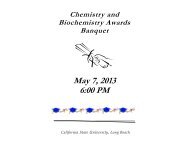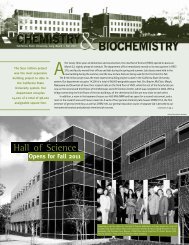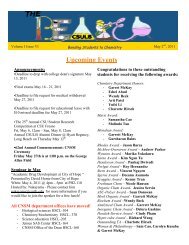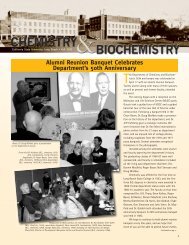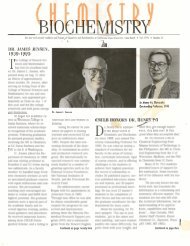2001 - California State University, Long Beach Department of ...
2001 - California State University, Long Beach Department of ...
2001 - California State University, Long Beach Department of ...
- No tags were found...
You also want an ePaper? Increase the reach of your titles
YUMPU automatically turns print PDFs into web optimized ePapers that Google loves.
Fall <strong>2001</strong> • Number 26by Glenn NagelDean • College <strong>of</strong> Natural Sciences and MathematicsIrecently attended a conference<strong>of</strong> college and university presidentsand deans at Fermi NationalLaboratory outside <strong>of</strong> Chicago. Theconference was sponsored by fiveprivate foundations (Camille andHenry Dreyfus, W. M. Keck, M. J.Murdock, Research Corp. andRobert A. Welch Foundation) thathave been strong supporters <strong>of</strong> undergraduatestudent research.The purpose <strong>of</strong> the conferencewas to release the results (539pages) <strong>of</strong> a study undertaken toprovide a basic understanding <strong>of</strong>the environment for research inthe natural sciences at predominatelyundergraduate colleges anduniversities. CSULB was one <strong>of</strong>136 institutions invited to contributedata and opinions to thestudy. Other institutions includedliberal arts colleges (e.g., Bates,Carleton, Harvey Mudd, Knox,Middlebury, Mount Holyoke, Occidentaland Pomona Colleges) aswell as larger colleges and universities(e.g., William and Mary,Western Washington, NorthernArizona and Rochester Institute <strong>of</strong>Technology). Three CSU campuseswere represented (CSULB, CalPoly SLO and San Jose <strong>State</strong>). Inthe words <strong>of</strong> Dr. Michael Doyle,vice president <strong>of</strong> Research Corp.,“These institutions have served asa national resource for a significantproportion <strong>of</strong> students whoundertake pr<strong>of</strong>essional careers inthe sciences and a primary reasonfor their output has been the researchexperiences <strong>of</strong> undergraduatestudents with faculty mentors.”The foundations were concerned,however, that the number <strong>of</strong> proposalsfrom science faculty wasdecreasing and that the opportunitiesfor external funding wereshrinking.I am happy to report that theconcerns <strong>of</strong> the organizers did notapply to our institution. CSULBranked #9 <strong>of</strong> 136 in the number<strong>of</strong> research grants awarded and #4in the number <strong>of</strong> baccalaureate degreesconferred in the sciences. Inaddition, 87 students earningbachelor’s degrees in the sciencesfrom CSULB were granted PhD degreesbetween 1991 and 1999.While we are very proud <strong>of</strong>these accomplishments, there wassome room for concern. One calculationmade from the study wasthat it takes, on the average, morethan $35,000 in funding to producea published paper in a firstratescience journal. We stronglybelieve that student co-authorship<strong>of</strong> a research paper is a real mark<strong>of</strong> the quality <strong>of</strong> the work beingdone in our laboratories. Our costat CSULB was actually somewhathigher than the $35,000 figure,indicating that we either need tobe more aggressive in publishingwork or that we need to attractmore funding in order to increaseour publication rate with students.I believe strongly we must doboth. What can you as alumni andfriends <strong>of</strong> CSULB Chemistry andBiochemistry do to help us in ourquest <strong>of</strong> Academic Excellence? Thefirst is all important: promote ourprogram to your peers and associatesand encourage talented studentsto apply for admission here.Second, we are always in need <strong>of</strong>funds to support student-facultyresearch. Your contributions canhelp support student researchfellowships, lab materials andsupplies, or costs associated withthe presentation and publication<strong>of</strong> results.If you wish to let us know<strong>of</strong> a student who is interested inapplying or has applied to CSULB,you can reach me by calling562/985-1521 or by e-mail(gnagel@csulb.edu). Donations tosupport undergraduate researchin Chemistry and Biochemistrymay be made via Dr. Marsi as isdescribed elsewhere in thisnewsletter.Your support and continuinginterest in science at CSULB isdeeply appreciated. ■EditorialB o xC S U L BChemistry and Biochemistry<strong>Department</strong> NewsletterFall <strong>2001</strong>, Number 26An annual publication <strong>of</strong> the<strong>Department</strong> <strong>of</strong> Chemistry and Biochemistryfor past and present studentsand friends <strong>of</strong> the department.News items, feature articles,photos and comments are eagerlyinvited. All articles not signed inthis issue <strong>of</strong> the Newsletter wereresearched and written by theEditor. The Newsletter and otherdepartmental news and informationmay be accessed on the Internet atthe following address:http://www.chemistry.natsci.csulb.edu.To send information about yourselfelectronically for publication in theNewsletter, (1) open up the Website indicated above, (2) click onNewsletter, (3) click on the Fall<strong>2001</strong> logo, (4) on the side bar,scroll to Alumni Response.Kenneth L. Marsi, Editor562/985-4941e-mail: kmarsi@csulb.eduAllergan Distinguished Visiting Lecturerby Tom MaricichCollege <strong>of</strong> Natural Sciences and MathematicsAppreciation is extended toConnie Lane, Publications Office,for the Newsletter layout and toBob Freligh, Audio Visual Services,for many <strong>of</strong> the photographs containedin this Newsletter.The 22nd Annual DistinguishedVisiting Lecturer was Dr.Catherine Fenselau, pr<strong>of</strong>essor <strong>of</strong>chemistry at the <strong>University</strong> <strong>of</strong>Maryland. Dr. Fenselau received anAB from Bryn Mawr College, andher PhD from Stanford <strong>University</strong>,where she worked with Dr. CarlDjerassi. She is a former president<strong>of</strong> the American Society <strong>of</strong> MassSpectroscopy. She is also the recipient<strong>of</strong> the Garvan Metal <strong>of</strong> theAmerican Chemical Society, theMaryland Chemist Award and theMerit Award <strong>of</strong> the National Institutes<strong>of</strong> Health. Dr. Fenselau is thenewly elected chair <strong>of</strong> the AnalyticalDivision <strong>of</strong> the AmericanChemical Society. Since she trainedas an organic chemist, the widescope <strong>of</strong> her expertise isreflected in the breadth <strong>of</strong> her recentpublications, appearing inAnalytical Chemistry and in Cellularand Molecular Biology.While at CSULB, Dr. Fenselaupresented two lectures to studentsand faculty, at times with standingroom only. In her first, a generallecture, titled “How Much DoThings Weigh?,” she presented thecapability <strong>of</strong> mass spectrometry toweigh individual molecules, molecularcomplexes and even smallviruses. Dr. Fenselau illustratedhow the determination <strong>of</strong> molecularmasses provided answers toimportant questions in biology,medicine and space travel.After an interactive luncheonwith students, Dr. Fenselau gavea more technical talk, titled“Chemistry <strong>of</strong> Zinc-Binding ProteinsStudied with ElectrosprayMass Spectrometry” to a crowd <strong>of</strong>chemists and biologists. Her revolutionarytechniques for accurateanalysis <strong>of</strong> high molecular weightproteins (greater than 30K Daltons)is paving the way for betterunderstanding <strong>of</strong> these proteins.Dr. Fenselau and her co-workershave used electrospray MS at pH8.0 in combination with accuratemass measurements to confirm themultiplicity <strong>of</strong> insulin in stablenon-covalent complexes with zincions. They showed that the natureand number <strong>of</strong> ligands involved inchelation agrees with resultsfrom crystal andsolution structures.Counting the number<strong>of</strong> ligands participatingin each centerallowed deduction<strong>of</strong> the geometricconfiguration <strong>of</strong> theligand field and gaveindirect information about theconformational state <strong>of</strong> the insulinmonomers in solution.An enthusiastic discussionensued, which has led to newdialog between our universitiesand between differentdisciplines.The lecture was followedby a receptionand dinner at Andiamo’sRestaurant in <strong>Long</strong> <strong>Beach</strong>.This lectureship issponsored by a generousgift from Allergan Pharmaceuticals,Inc. ■3


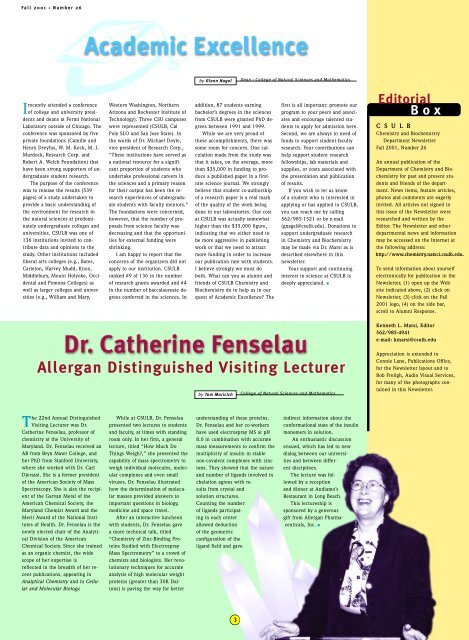
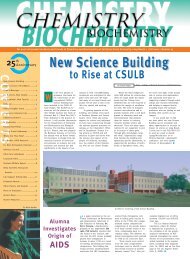
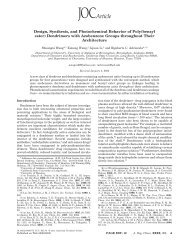
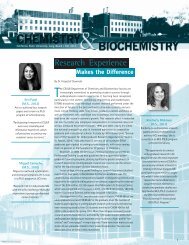
![Volume 4, Issue 3 [November 2012 pdf] - California State University ...](https://img.yumpu.com/34605825/1/190x245/volume-4-issue-3-november-2012-pdf-california-state-university-.jpg?quality=85)
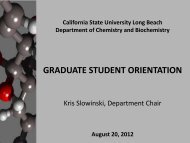
![Volume 5, Issue 2 [April 2013 pdf] - California State University, Long ...](https://img.yumpu.com/33273195/1/190x245/volume-5-issue-2-april-2013-pdf-california-state-university-long-.jpg?quality=85)
